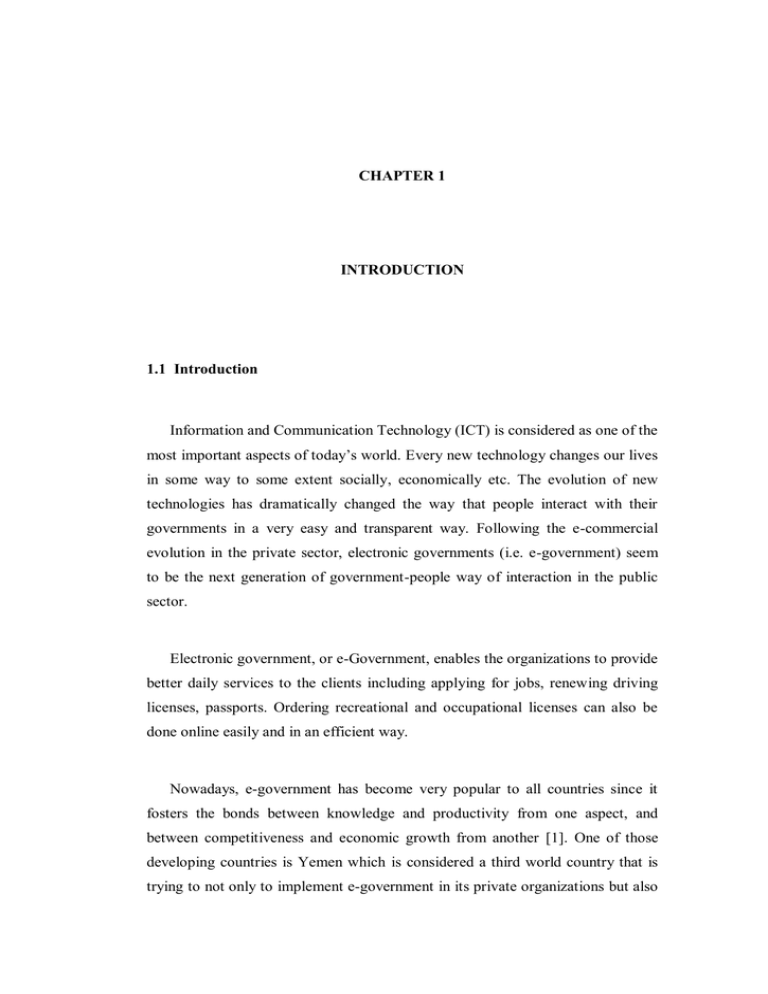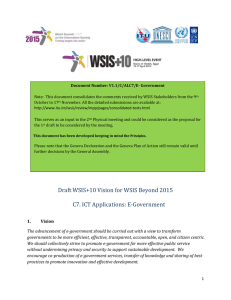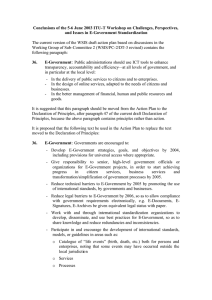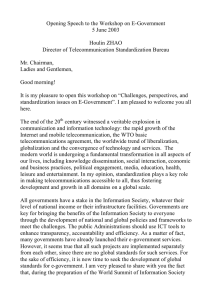1 Information and Communication Technology (ICT) is considered as one of... most important aspects of today’s world. Every new technology changes...
advertisement

1 CHAPTER 1 INTRODUCTION 1.1 Introduction Information and Communication Technology (ICT) is considered as one of the most important aspects of today’s world. Every new technology changes our lives in some way to some extent socially, economically etc. The evolution of new technologies has dramatically changed the way that people interact with their governments in a very easy and transparent way. Following the e-commercial evolution in the private sector, electronic governments (i.e. e-government) seem to be the next generation of government-people way of interaction in the public sector. Electronic government, or e-Government, enables the organizations to provide better daily services to the clients including applying for jobs, renewing driving licenses, passports. Ordering recreational and occupational licenses can also be done online easily and in an efficient way. Nowadays, e-government has become very popular to all countries since it fosters the bonds between knowledge and productivity from one aspect, and between competitiveness and economic growth from another [1]. One of those developing countries is Yemen which is considered a third world country that is trying to not only to implement e-government in its private organizations but also 2 in its governmental agencies.The Yemeni government is trying to find the appropriate e-governmentframework to enhance the economic growth and provide people withthe best and fastest services offered by this new technology [2]. 1.1.1 Background of the Republic of Yemen Yemen is one of the developing countries, located in theSouthern part of the Arabian Peninsula. It is bordered by Saudi Arabia to the north and by the red sea to the west and Oman to the east .The total area of the Republic of Yemen is about 555,000 square kilometer,and the population of Yemen is 22 million. The officiallanguage of the country is Arabic and Islam is the official religion of the country. TheRepublic of Yemen is one of the poorest countries in the Arab World. Ithas reported strong growth since 2000, and its economic fortunes dependmostly on oil. The government is represented by the president initiated aplan to develop the new country infrastructure and build a democraticadministrative system, which is responsible for the provision of publicservices to all Yemenis whether in the country or abroad. According to Alsohybe,[3] the Republic of Yemen longterm’s strategy aimed todevelop a reliable and efficient administration and government by improving and reforming its ministries and institutions to deliver betterpublic services for all its citizens and gain recognition around the world. 1.1.2 E-government of the Republic of Yemen Nowadays, organizations and even the governments depend on the Information systems and technology in processing their jobs [4]. Therefore, it has been noticed that majority of the governments have plans to implement information technology and e-government in all of their work processing and communication tools. 3 One of the third world countries is the Republic of Yemen which is trying to implement e-government not only in its private organizations but also in the governmental agencies. The Republic of Yemen has already initiated an egovernment plan that costs around 60million USD and implemented some phases. The phases that the Yemenigovernment is trying to implement is as follows: [5] i. This phase included thedissemination of basic information, about all ministries and government agencies through a specific website, where the various ministries and is currently preparing the introduction of their own information to this site as a general framework for the Government (http://www.yemen.gov.ye/portal). ii. The second phase that includes the mutual Information System that the websites can allow for inquiries and exchange the data throughout it. iii. The third phase is exchange the benefits and values between the citizens and government via websites by direct contact between the parties. iv. The fourth phase is integration of services and benefits by using portal systems which will integrate many government services in accordance with the priorities and tasks. The phases mentioned above have not been implemented yet except the first phase which started with five ministries that consider the main part of the economy and social services in the Republic of Yemen. In addition, the Yemeni government is trying to find the appropriate e-government model to enhance the economic growth and provide the people with the best and fastest services offered by this new technology. In the following section of this chapter, the researcher presents the problem background of the research, objectives and also the significant of the study. 4 1.2 Problem Background Nowadays, governments are measured by their citizens’ satisfaction. Yemeni government,as an example, is trying to keep pace with the developed countries in various fields. Yemeni government, nowadays, is facing a lot of challenges as to providing daily civil services electronically which is of a major challenge. Although, the Yemen government has initiated and proposed an egovernment project to overcome the current manual systems problems but they still not implemented the real e-government in terms of government services. They have implemented the first phase of the project which is dissemination of basic information, about all ministries and government agencies through a specific websites. Since the Yemeni government has started implementing the e-government in all ministries and government agencies, they are willing to move towards becoming more efficient operationally by collaborating across traditional departments and government agencies. Therefore, the government has to become more responsive towards the needs of Yemeni citizens. In addition, the government faces increased pressures from the citizen to manage their daily procedures and work electronically. The e-Government should purposely bring public services online and also focus mainly in reducing the overall operational costs by transforming the e-Government into an organization that generates both social and economic values effectively.Yemen public agencies need a clear insight to the benefits. Anything that is planned and will be executed requires a measurement yardstick to track the progress. There is a need to illustrate and benchmark the Yemen e-Government achievement, as compared to the progress of other e-Governments of peer countries and their initiatives. 5 Requirements and challenges that slow down the implementation of the eGovernment initiative are important to be known so that it can be tackled at early stages. Government agencies are developing websites for the purpose of web presence while unintentionally creating scattered clusters of static information on the Internet. The formation of these decentralized services in turn gives customers the run-around when they are seeking public services. In addition, most of the government websites provide a good graphic interface design and have some information, but they don’t provide methods for citizens for relevant service information, and there is no interacting with the government agencies (http://www.yemen.gov.ye/portal/mohe). Besides that, all of the e-government websites have no multi-languages which are important to the foreigner visitors.As a result, the government finds difficulties in building the citizen satisfaction. This is because, the citizens are not engaging with government. Therefore, when the government wants to reach its vision and mission they must provide the services to engage the citizen to support the government. As a summary , the current e-government service implementation in the Ministry of Higher Education and Scientific Research (MoHESR) has some limitations and weaknesses such as the website is poor of information needed to citizen ,services provided are limited and no online interaction services are provided (still using manual forms).In addition, this study will explore more on the problem and limitations in MoHESR current e-government service implementation and then propos the most appropriate e-government service model in order to overcome all the limitations and weaknesses. 1.3 Problem Statement 6 This research attempt to answer the main research question: I. How to develop an e-government model in improving e-services for Ministry of Higher Education and Scientific Research (MoHESR) in the republic of Yemen Sub-questions: i. What is the current implementation of e-government in MoHESR ? ii. What are the e-services requirements of e-government for MoHESR? 1.4 Research Objectives The objectives for this research are: i. To analyze the current implementation of MoHESR E-government in the republic of Yemen and find out its strength and weaknesses. ii. To identify the e-services requirements of MoHESR for Republic of Yemen e-government. iii. To propose E-government model with the improvement of eservices for MoHESR of the republic of Yemen. iv. To evaluate the proposed model. 1.5 Scope of the Research 7 This research will focus on the e-government in Yemen .The researcher will talk about the Yemeni e-government in general and will go specifically for one of the government agencies. The researcher selects the Ministry of Higher Education and Scientific Research (MOHESR) as the government agency. The researcher will also go in details for the category of G2C (government to citizen) and more specifically on the online services provided by Ministry of Higher Education.





